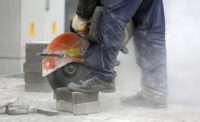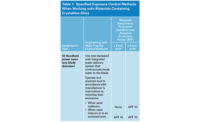Employers and employees are still grappling with OSHA’s Crystalline Silica Standard a year after it became effective.
Why all the fuss?
Examples of work activities that can generate respirable silica dust particles include:
- fabrication and installation of composite (engineered or manufactured) stone countertops
- excavation, earth moving and drilling plant operations
- mining, quarrying and mineral ore treating processes
- general construction activities
- brick, concrete or stone cutting; especially using dry methods
- foundry casting
- angle grinding, jack hammering and chiselling of concrete or masonry
- hydraulic fracturing of gas and oil wells, and many more.
OSHA estimates some two million construction employees are exposed to respirable crystalline silica in more than 600,000 workplaces across the country. To comply, companies need to follow multiple steps that aren’t always as easy as they might seem. Construction and related workers are typically mobile and job locations change regularly.
Compliance tips
Here is a series of steps employers need to take to be in compliance:
Identify which specific work tasks may expose an employee to silica dust. Not all jobsites are the same and new projects start regularly. What happens if a new hazard is missed when a job expands or scope changes? Keep regular records of job activities.
Evaluate exposure to silica dust. Exposure to respirable crystalline silica can be evaluated one of three ways:
- Referencing Table 1 of the OSHA Respirable Crystalline Silica Standard for Construction
- Referencing applicable objective exposure data
- Conduct air monitoring- which is the most accurate and valuable to employees
Develop an exposure control plan for the identified tasks or operations. Review work tasks and talk to employees about various ways to reduce exposure. The struggle for many employers is what kind of questions do you ask? What kinds of answers will workers give? Plan for this engagement in advance. Be prepared for deep insight into the job that might be more complicated than some in management thought or expected. Employer preparation for this process is critical.
Implement engineering/administrative controls to minimize exposure as needed. Engineering controls such as exhaust ventilation/dust suppression systems as well as vacuums integrated into some power tools afford excellent protection but just aren’t always feasible on a jobsites or remote locations. The concept of job rotation schedules and using work scheduling that limits the amount of time employees are exposed isn’t always an easy concept when building or project deadlines are in place.
Determine the need for respiratory protection and/or a medical surveillance program based on exposure evaluation results. Respiratory protection may be necessary when engineering or work practice controls are not effective in minimizing employees’ exposure to respirable crystalline silica, but that doesn’t mean that medical evaluations, training and fit testing will be easy. With remote workers, far off jobsites and often transitory workers, providing respiratory protection can be a challenge, time-consuming and expensive. That said, with the right planning and product selection it can be done effectively. Worksites are busy, dirty and loud. How do you get rough and tumble construction or trade worker to comply? How do you get remote workers in for a medical evaluation? It’s not easy. Cultural planning, job timing strategies and union or trade group requirements become critical.
Workers wearing respiratory protection must be trained in its proper use, such as donning and doffing correctly, filter change schedules -- all done according to manufacturer’s guidelines. These are all critical issues to evaluate when developing a plan, not when implementing a plan.
Develop and provide employee training. Companies must review and update their hazard communication training programs to now include silica-specific information, including tasks with potential exposure to silica. Employers now must provide training on how to reduce risk of exposure, and notify employees of results and corrective actions. Maintaining medical and exposure records are now critical as well. Like the topics discussed earlier, training is hard when you have remote jobsites and critical deadlines. Advance planning and scheduling is critical.
Compliance isn’t getting any easier
OSHA began enforcing the silica rule in the construction industry in June of 2018. Since then, there have been hundreds of fines issued, with one more than $300,000. Fines for violating the silica standard are not trivial. Most citations fall under the OSHA serious violation category.
The regulation could possibly expand. On August 15, 2019, OSHA announced it is seeking comment and information on additional engineering and work practice control methods to effectively limit exposure to silica for the equipment and tasks currently listed on Table 1. The agency is also requesting information about other construction equipment and tasks that generate silica that it should consider adding to Table 1, along with information about their associated engineering and work practice control methods.
Keeping the worker safe & going home to their family
Silica safety must go far beyond, “Hey it’s a new OSHA reg, wear your respirator.” There is a bigger return on investment for workers who embrace the need for protection and assist in compliance than there is for the company’s financial and legal exposure. Silica doesn’t strike today like an eye injury or slip and fall, silica exposure is a chronic long-term debilitating problem. Workers and management alike need to team up to reduce hazards and risks of silica exposure.



